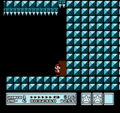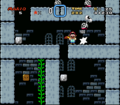Shifting wall
| Shifting wall | |||
|---|---|---|---|
 Screencap from New Super Mario Bros. | |||
| First appearance | Super Mario Bros. 3 (1988) | ||
| Latest appearance | Nintendo World Championships: NES Edition (2024) | ||
| |||
| |||
Shifting walls,[1] also called crushing pillars[2] and moving blocks,[3] are hazardous obstacles in the Super Mario series, appearing mainly in towers and castles, going back and forth on a specific axis (either vertical or horizontal). If they manage to squash Mario onto another surface, they may cause him to lose a life.
History
Super Mario Bros. 3 / Super Mario Advance 4: Super Mario Bros. 3
Shifting walls debuted in Super Mario Bros. 3 in the second room of World 1-![]() Fortress, where spikes are attached to the ceiling and are lowered to squash and impale Mario, unless he ducks in a designated place. Alongside the ceiling, the door to the boss also moves and lowers into the ground. Later, in World 2-
Fortress, where spikes are attached to the ceiling and are lowered to squash and impale Mario, unless he ducks in a designated place. Alongside the ceiling, the door to the boss also moves and lowers into the ground. Later, in World 2-![]() Fortress, in the second room, many wooden blocks with spikes on the lower and upper surface appear as obstacles that move with the door.
Fortress, in the second room, many wooden blocks with spikes on the lower and upper surface appear as obstacles that move with the door.
Super Mario World / Super Mario World: Super Mario Advance 2
Spikeless shifting walls appear in Super Mario World, textured like the walls of the castle. In #2 Morton's Castle, in the penultimate room, shifting walls stick out from the walls and both create a passage to the upper part of the room and serve as obstacles that can crush Mario in certain places. Towards the end of the room, some of them even have spikes, in case he falls in narrow holes. These type of shifting walls also appear in the sixth room of Bowser's Castle. In #3 Lemmy's Castle, the third room is a long lava-filled hall with shifting floor and ceilings that can either squash Mario or create platforms to help him cross the lava. In #4 Ludwig's Castle, a lowering spiked ceiling is the main obstacle of the penultimate room and can be stopped and pulled back to the top with an ON/OFF Switch. In the Lil Sparkies and the Hotheads room in #6 Wendy's Castle and the fourth room of Bowser's Castle, small, light-gray, squared shifting walls appear along the regular shifting walls as small platforms to cross the pits.
New Super Mario Bros.
Shifting walls reappear as obstacles in New Super Mario Bros. in towers and castle levels, still used as squashing obstacles and platforms/stairways. Both smooth and spiked variants appears. They have a light-gray stone texture.
- Appearances
Super Mario Galaxy
Crushing pillars appears with a mechanical design in Super Mario Galaxy, in the inner sections of the Battlerock Galaxy and Dreadnought Galaxy.
- Appearances
| Domes | Galaxies | Missions | ||||||
|---|---|---|---|---|---|---|---|---|
| Fountain | Battlerock Galaxy | |||||||
| Garden | Dreadnought Galaxy | |||||||
New Super Mario Bros. Wii
In New Super Mario Bros. Wii, shifting walls have the same function as in previous titles, but now have a brown, smoothed texture. In World 5-![]() Tower, pairs of spiked shifting walls (textured like a normal wall) move in parallel left and right, narrowing the safe space on the screen.
Tower, pairs of spiked shifting walls (textured like a normal wall) move in parallel left and right, narrowing the safe space on the screen.
- Appearances
New Super Mario Bros. 2
In New Super Mario Bros. 2, shifting walls returns with the same design from the previous title. In World 1-![]() Castle, however, vertical shifting walls are designed like castle pillars, with variable length and they can have spikes on either the upper or lower surface. In World 2-
Castle, however, vertical shifting walls are designed like castle pillars, with variable length and they can have spikes on either the upper or lower surface. In World 2-![]() Ghost House, during the Boohemoth section, there are purple-checkered solid platforms that move both vertically or horizontally, or swing like a seesaw.
Ghost House, during the Boohemoth section, there are purple-checkered solid platforms that move both vertically or horizontally, or swing like a seesaw.
- Appearances
New Super Mario Bros. U / New Super Luigi U / New Super Mario Bros. U Deluxe
In New Super Mario Bros. U and New Super Luigi U, moving blocks appear with a reworked brown design in Layer-Cake Desert-Castle and looking like the castle's walls in Soda Jungle-Castle. In Stonecrush Tower, stones nailed together appear as the moving blocks.
- Appearances
| New Super Mario Bros. U | New Super Luigi U |
|---|---|
Gallery
A shifting spiked ceiling in Super Mario Bros. 3
Sprite of a shifting wall from #6 Wendy's Castle and room 4 of Bowser's Castle in Super Mario World
The room in #2 Morton's Castle with shifting walls in Super Mario World
Sprites of shifting walls with spikes in New Super Mario Bros.
Mario approaching a crushing pillar in Super Mario Galaxy
Shifting walls in New Super Mario Bros. Wii
Mario dangling over some shifting pillars in New Super Mario Bros. 2
Mario surrounded by shifting walls in New Super Mario Bros. U
Shifting walls in New Super Luigi U
Names in other languages
| Language | Name | Meaning | Notes |
|---|---|---|---|
| Japanese | 動く壁[4]:118 Ugoku Kabe |
Moving Wall | |
| 動く床[4]:215 Ugoku Yuka |
Moving Floor | New Super Mario Bros. U | |
| Italian | Muro che si muove in orizzontale[5]:57 | Horizontal moving wall | Super Mario World |
| Piattaforma mobile[5]:116 | Moving platform | New Super Mario Bros. | |
| Parete mobile[5]:116-18 | Moving wall | ||
| Parete mobile spinosa[5]:117 | Spiked moving wall | ||
| Parete piena di spuntoni che si muove lateralmente[5]:148 | Spiked wall that moves sideways | New Super Mario Bros. Wii | |
| Piattaforma [che] si muove lateralmente[5]:212 | Platform that moves sideways | New Super Mario Bros. U | |
| Piattaforma che sale e scende[5]:213 | Platform that goes up and down |
References
- ^ Bueno, Fernando (2009). New Super Mario Bros. Wii: PRIMA Official Game Guide. Roseville: Prima Games (American English). ISBN 978-0-3074-6767-6. Page 159.
- ^ Black, Fletcher (2007). Super Mario Galaxy: PRIMA Official Game Guide (Collector's Edition). Roseville: Prima Games. ISBN 978-0-7615-5713-5. Page 111.
- ^ Stratton, Steve (2012). New Super Mario Bros. U: PRIMA Official Game Guide. Roseville: Prima Games. ISBN 978-0-307-89690-2. Page 72, 73.
- ^ Jump up to: a b Sakai, Kazuya (ambit), kikai, Akinori Sao, Junko Fukuda, Kunio Takayama, and Ko Nakahara (Shogakukan), editors (2015). 『スーパーマリオブラザーズ百科: 任天堂公式ガイドブック』. Tokyo: Shogakukan (Japanese). ISBN 978-4-09-106569-8.
- ^ Jump up to: a b c d e f g Sakai, Kazuya (ambit), kikai, Akinori Sao, Junko Fukuda, Kunio Takayama, Ko Nakahara (Shogakukan), and Marco Figini, editors (2018). Super Mario Bros. Enciclopedia. Translated by Marco Amerighi. Milan: Magazzini Salani (Italian). ISBN 889367436X.
| show Super Mario Bros. 3 / Super Mario Advance 4: Super Mario Bros. 3 |
|---|
| showSuper Mario World / Super Mario World: Super Mario Advance 2 |
|---|
| show New Super Mario Bros. |
|---|
| show Super Mario Galaxy |
|---|
| show New Super Mario Bros. Wii |
|---|
| show New Super Mario Bros. 2 |
|---|
| show New Super Mario Bros. U / New Super Luigi U / New Super Mario Bros. U Deluxe |
|---|














